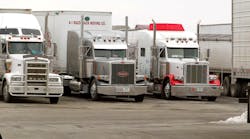The good news is that the vast majority of drivers – both ELD and non-ELD users – spend less than 15 minutes searching for a parking spot. The bad news is that these same drivers purposely cut short their driving times – 40% report a loss of 31-60 minutes and 32 percent lose 61-120 minutes – because they fear not getting a legal parking space before they must get off the road.
The report estimates that with almost an hour of driving time cut short daily, average drivers sacrifice about $4,600 a year. That figure that may be unrealistic, however, because it assumes that a parking spot will appear as soon as drivers hit their driving limit.
Nonetheless, parking challenges will be made worse when electronic logging device (ELD) regulations are fully in place, a just-published American Transportation Research Institute survey noted. About 71% of ELD and 77% of non-ELD drivers spend less than 15 minutes finding a parking space, about 10% extra time for those with ELDs. For those drivers who took 16 to 30 minutes of search time, the numbers were closer, 19% for ELD and 17% for non-ELD. Of those who searched for more than 30 minutes, 11% were ELD users and 6% used paper logs, a much larger disparity.
"It's more of a spread than with the [first two], enough so that it became noticeable to us in terms of the time drivers spend," says Rebecca Brewster ATRI President and Chief Operating Officer. "It also corroborated what we saw in the open-ended responses from drivers who said, 'When I'm operating with my ELD, I know I don't have any time to spare. I know I need to go ahead and find a place now rather than risk running out of hours down the road. I don't have the flexibility that a driver who isn't on an ELD may have.'"
The problem arises because of how each system – ELDs and paper logs – reports driving time. The report noted: "The observed increase in search time for ELD users is likely caused by the differential in flexibility between ELDs and paper logs. ELDs automatically record change of duty status to the minute, while paper logs use 15-minute blocks. The ELD mandate will take away the flexibility that drivers with paper logs currently have and drivers may adjust behaviors to find safe parking with reduced flexibility. These behavioral changes may include using drive time to search for parking."
Another issue that the study brought to light is that the time of day impacts the parking shortage It's no surprise that search time peaks between 4 p.m. and 11:59 p.m. and the shortage is exacerbated by non-CMVs occupying truck parking spaces. "The solution doesn't require more pavement to deal with," says Brewster, "just better policing of those spaces." Survey takers also chided other truckers for taking more than one designated space for their vehicles.
Data for the report came from 148 completed diaries that were returned to ATRI between June and September 2016, representing a total of 2,035 days of truck parking activity and 4,763 unique stops. Of over 650 drivers who submitted qualifying surveys, 587 were selected for participation. Brewster notes that the attrition was due to the onus of filling out the diaries over a two-week period. "I really do want to express how grateful we are to drivers who did take the time to do this. In terms of data lift, this was the heaviest sort of request we've had for participants in research for drivers in quite some time. The fact that 148 is certainly less than we would've liked, but for the 148 drivers, this was a big time commitment. We appreciate it."
Most of the participants were in the truckload sector (56.1%), operated in the Midwest (35.5%) and Southeast (28.9%), drove dry vans (41.2%), were age 45-64 (71.4%), and were employee drivers (72.3%). To find parking spots most used multiple sources including websites or apps (55.5%), GPS (53.4%) and books (37.7%).
The report recommended the following actions to help alleviate parking shortages keyed to specific stakeholders:
- Public Sector: Low-cost solutions to inadequate parking supply include increasing public rest area time limits to allow drivers to take mandatory HOS breaks and allowing parking at public facilities such as weigh stations and public works facilities. Long-term solutions require increased investments, such as reopening public rest areas that have been closed, expanding existing facilities, or developing new facilities.
- Truck Stop Operators: Inadequate supply could be improved by expanding existing private sector parking locations or building new ones. However, these solutions are capital-intense and face numerous legal obstacles, although there is some precedent for private truck stops using public sector funding. Separate parking for non-CMVs such as RVs and bobtails would free up spaces for tractor-trailers.
- Motor Carriers: Carriers could pay for reserved spots (about 15 percent of drivers surveyed enjoy this service). This not only would increase driving miles but increase productivity beyond the cost of the fee. If carrier-paid reservation fees improve driver retention rates, that could lead to reduced training costs.
- Shippers/Receivers: Providing drivers more flexibility in appointment times would allow drivers to shift times of operation to off-peak hours when there are more parking spaces.
- Truck Drivers: Drivers’ open-ended responses indicate that planning is crucial to maximizing revenue-earning miles. Time spent searching for parking can be reduced by taking 10-hour required HOS breaks during off-peak demand hours, typically 5:00 a.m. – 4:00 p.m. Shifting days of operation to include weekends may additionally improve productivity, as there are fewer parking issues on weekends relative to weekdays.
Will ATRI do another survey? "It certainly will be interesting to see how this dynamic changes in five years when we have ELDs, and when, hopefully, we'll see more of a focus on infrastructure in the new administration," Brewster says.



